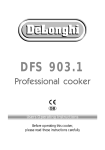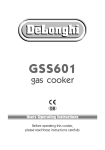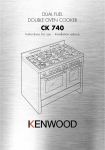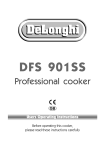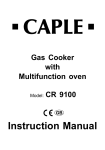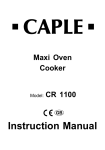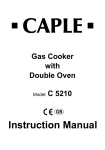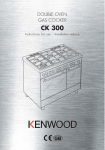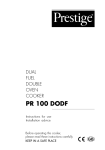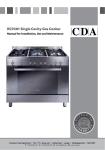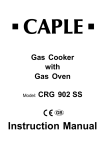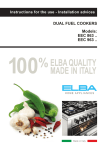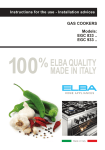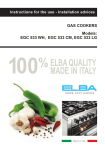Download DeLonghi WIR2 LP GAS Operating instructions
Transcript
DFG 903 Professional cooker GB Users Operating Instructions Before operating this cooker, please read these instructions carefully Dear Customer Thank you for choosing one of our appliances which has been carefully designed and built by our specialist staff and thoroughly tested to satisfy your cooking requirement. We suggest that you read this Instruction Booklet so that you will understand fully how to operate the appliances. Please keep the booklet handy. You may wish to refer to it at a later date. De Longhi 2 Contents Model DFG 903 Page Number Introduction . . . . . . . . . . . . . . . . . . . . . . . . . . . . . . . . . . . . . . . . . . . . . . . . . . . . . 4 Assembling the backguard . . . . . . . . . . . . . . . . . . . . . . . . . . . . . . . . . . . . . . . . . 4 Features and technical data . . . . . . . . . . . . . . . . . . . . . . . . . . . . . . . . . . . . . . . . . 5 Control panel . . . . . . . . . . . . . . . . . . . . . . . . . . . . . . . . . . . . . . . . . . . . . . . . . . . . 6 Minute counter . . . . . . . . . . . . . . . . . . . . . . . . . . . . . . . . . . . . . . . . . . . . . . . . . . . 7 How to use the hob burners . . . . . . . . . . . . . . . . . . . . . . . . . . . . . . . . . . . . . . . . 8 How to use the gas oven . . . . . . . . . . . . . . . . . . . . . . . . . . . . . . . . . . . . . . . . . . .11 How to use the grill . . . . . . . . . . . . . . . . . . . . . . . . . . . . . . . . . . . . . . . . . . . . . . .13 Oven light . . . . . . . . . . . . . . . . . . . . . . . . . . . . . . . . . . . . . . . . . . . . . . . . . . . . . . .14 Important notes . . . . . . . . . . . . . . . . . . . . . . . . . . . . . . . . . . . . . . . . . . . . . . . . . .15 After sales service . . . . . . . . . . . . . . . . . . . . . . . . . . . . . . . . . . . . . . . . . . . . . . . . .15 Do’s and do not’s . . . . . . . . . . . . . . . . . . . . . . . . . . . . . . . . . . . . . . . . . . . . . . . . .16 Care and maintenance . . . . . . . . . . . . . . . . . . . . . . . . . . . . . . . . . . . . . . . . . . . . .17 For the installer Location . . . . . . . . . . . . . . . . . . . . . . . . . . . . . . . . . . . . . . . . . . . . . . . . . . . . . . . 22 Fitting the adjustable feet . . . . . . . . . . . . . . . . . . . . . . . . . . . . . . . . . . . . . . . . . . .23 Stability bracket . . . . . . . . . . . . . . . . . . . . . . . . . . . . . . . . . . . . . . . . . . . . . . . . . .24 Provision for ventilation . . . . . . . . . . . . . . . . . . . . . . . . . . . . . . . . . . . . . . . . . . . .25 Gas installation . . . . . . . . . . . . . . . . . . . . . . . . . . . . . . . . . . . . . . . . . . . . . . . . . . .26 Conversion to LPG . . . . . . . . . . . . . . . . . . . . . . . . . . . . . . . . . . . . . . . . . . . . . . . .28 Lubrication of the gas taps . . . . . . . . . . . . . . . . . . . . . . . . . . . . . . . . . . . . . . . . . .33 Electrical installation . . . . . . . . . . . . . . . . . . . . . . . . . . . . . . . . . . . . . . . . . . . . . . .34 3 Introduction Congratulations on your purchase of this Delonghi gas cooker which has been carefully designed and produced to give you many years of satisfactory use. Before using this appliance it is essential that the following instructions are carefully read and fully understood. We would emphasise that the installation section must be fully complied with for your safety to ensure that you obtain the maximum benefits from your appliance. Backguard B Before installing the cooker, assemble the backguard “C” (fig. 1). Please note that : • The backguard “C” can be found packed at the rear of the cooker. • Before assembling remove any protective film/adhesive tape. • Remove the two spacers “A” and the screw “B” from the rear of the cooktop. • Assemble the backguard as shown in figure 1 and fix it by screwing the central screw “B” and the spacers “A”. A Fig. 1 This cooker has been designed, constructed and marketed in compliance with: - safety requirements of EEC Directive “Gas” 90/396; - safety requirements of EEC Directive “Low voltage” 73/23; - protection requirements of EEC Directive “EMC” 89/336; - requirements of EEC Directive 93/68. This appliance is designed and manufactured solely for the cooking of domestic (household) food and in not suitable for any none domestic application and therefore should not be used in a commercial environmement. The appliance guarantee will be void if the appliance is used within a none domestic environnement i.e. a semi commercial, commercial or communal environment. 4 Features and technical data Gas burners 1. 2. 3. 4. 5. 6. Gas oven Triple-ring burner (TC) Semi-rapid burner (SR) Rapid burner (R) Auxiliary burner (A) Semi-rapid burner (SR) Auxiliary burner (A) 3,50 kW 1,75 kW 3,00 kW 1,00 kW 1,75 kW 1,00 kW – Oven burner – Grill burner – Oven lamp 6,20 kW 4,65 kW 15 W – Usable oven volume 99,5 dm3 4 5 3 6 1 2 Identification label Fig. 2 When you open the oven door the indentification label is at the bottom right hand side. 5 Control panel Fig. 3 1 2 3 4 5 6 CONTROL PANEL - Controls description 1. Gas oven / gas grill control knob 2. Minute counter 3. Front left burner control knob 4. Rear left burner control knob 5. Front central burner control knob 6. Rear central burner control knob 7. Rear right burner control knob 8. Front right burner control knob 9. Oven light control knob 6 7 8 9 Minute counter Minute counter The minute counter is a timed acoustic warning device which can be set for a maximum of 60 minutes. The knob (Fig. 4) must be rotated clockwise as far as the 60 minute position and then set to the required time by rotating it anticlockwise. Fig. 4 7 How to use the hob burners Hob burners Each hob burner is controlled by a separate gas tap operated by a control knob (fig. 5) which has 3 positions marked on the control panel, these are: – Symbol ● : tap closed (burner off) – Symbol : High (maximum) – Symbol : Low (minimum) Push in and turn the knob anti-clockwise to the selected position. Low Fig. 5 High To turn the burner off, fully rotate the knob clockwise to the off position: ●. The maximum setting of the control tap is for boiling, the minimum setting is for slow cooking and simmering. All working positions must be choosen between the maximum and minimum setting, never between the maximum setting and the “OFF” position. Electric ignition The sparks generated by the electrodes close to the burners will ignite the choosen burner. Whenever the lighting of the burners is difficult due to peculiar conditions of the gas features or supply, it is advised to repeat the ignition with the knob on “minimum” position. Lighting of the hob burners To ignite the burner, the following instructions are to be followed: 1) Lightly press and turn the knob anti-clockwise, and position the knob indicator to the symbol printed on the control panel (fig. 5). 2) Press the knob to operate the electric ignition; or, in the case of a mains failure light the burner with a match or lighted taper. 3) Adjust the burner according to the setting required. 8 Choice of burner The burner must be choosen according to the diameter of the pans and energy required. Burners Pan diameter Auxiliary 12 ÷ 14 cm Semi-rapid 16 ÷ 24 cm Rapid 24 ÷ 24 cm Triple-ring 26 ÷ 28 cm Fig. 6a do not use pans with concave or convex bases Saucepans with handles which are excessively heavy, in relationship to the weight of the pan, are safer as they are less likely to tip. Pans which are positioned centrally on burners are more stable than those which are offset. It is far safer to position the pan handles in such a way that they cannot be accidentally knocked. When deep fat frying fill the pan only one third full of oil. DO NOT cover the pan with a lid and DO NOT leave the pan unattended. In the unfortunate event of a fire, leave the pan where it is and turn off all controls. Place a damp cloth or correct fitting lid over the pan to smother the flames. DO NOT use water on the fire. Leave the pan to cool for at least 30 minutes. AIR FLOW (cooling fan) AIR FLOW (cooling fan) AIR FLOW (cooling fan) CORRECT USE OF RAPID BURNER Fig. 6b 9 Correct use of the triple-ring burner The flat-bottomed pans are to be placed directly onto the pan-support. To use the WOK you need to place the proper stand in order to avoid any faulty operation of the triple-ring burner (Fig. 7a - 7b). CORRECT WRONG Fig. 7a 10 Fig. 7b How to use the gas oven Lighting the oven gas burner The thermostat allows the automatic control of the temperature. The gas delivery to the oven burner is controlled by a two way thermostatic tap (oven and grill burners) with flame-failure device. To light the oven burner operate as follow: 1) Open the oven door 2) Lightly press and turn the thermostat knob anti-clockwise to max position “ ”. 3) Press the knob right down to prime the electric ignition. WARNING: Risk of explosion! The oven door must be open during this operation. In case of power cut, press the knob and immediately approach a lighted match to the opening “A” (fig. 8). Never continue this operation for more than 15 seconds. If the burner has still not ignited, wait for about 1 minute prior to repeating the ignition. 4) Wait about 10/15 seconds after the burner lighting before releasing the knob (time of priming of the valve). 5) Close the oven door slowly and adjust the burner according to the power required. Should the flame of the burner estinguish for any reason, the safety valve will cut off automatically the gas flow to the tap. To re-start operation, take the knob to “off” position, wait for at least 1 minute and repeat operations as above explained. Oven thermostat The oven thermostat (fig. 9) is marked with numbers, these correspond to the oven temperature, in addition the “OFF” position is shown by the symbol ●. To choose the required oven temperature (check with the “Oven cooking temperatures”), turn the control knob until its line mark is level A with the number required on the control panel (facia). Fig. 9 Fig. 8 11 Oven cooking temperatures 12 MARK APPROX. TEMP. HEAT OF OVEN TYPE OF DISH TO COOK 150 150°C Very cool oven Meringue cakes, slow cooking items • 165°C Cool or slow oven Milk puddings, very rich fruit cakes, i.e., Christmas 180 180°C Cool or slow oven Stews, casseroles, braising, rich fruit cakes, i.e., Dundee • 195°C Warm oven Biscuits, rich plain cakes i.e., Madeira. Low temp. roasting 210 210°C Moderate oven Plain cakes, Victoria sandwich, raised meat pies • 225°C Fairly hot oven Small cakes, savoury flans, fish 240 240°C Hot oven Plain cakes and buns, swiss rolls, fruit pies. High temp. roasting • 245°C Moderately hot oven Bread and bread rolls etc., scones, flaky and rough puff pastry, yorkshire pudding 270 • 270 285 Very hot oven Sausage rolls, mince pies, puff pastry, pizza Browning ready cooked dishes How to use the gas grill Lighting the grill gas burner Do not grill with oven door closed. Always fit the heat shield supplied with the cooker under the front panel before commencing operations (Fig. 12). WARNING. The heat shield and the oven door reaches a very high temperature whilst in use. Keep children away and allow to cool before removing. The grill burner generates the infra-red rays for grilling. To light the grill burner operate as follow: 1) Open the oven door. 2) Lightly press and turn the thermostat knob clockwise to the 3) Press the knob right down to prime the electric ignition. WARNING: Risk of explosion! The oven door must position (fig. 11). be open during this operation. In case of power cut, press the knob and put a lighted match to the right and left side of the burner (fig. 10). Never continue this operation for more than 15 seconds. If the burner has still not ignited, wait for about 1 minute prior to repeating the ignition. 4) Wait about 10/15 seconds after the burner lighting before releasing the knob (time of priming of the valve). 5) Half-close the oven door slowly. Should the flame of the burner estinguish for any reason, the safety valve will cut off Fig. 11 automatically the gas flow to the tap. To re-start operation, take the knob to “off” position, wait for at least 1 minute and repeat operations as above explained. Fig. 10 13 Notes: – The grill burner has only one setting, that is full-on – It is important that the heat shield is fitted the correct way up, as shown in the figure 12. Fig. 12 IMPORTANT WARNING For best results when using the grill, place the shelf on the second level and when using the grill pan handle avoid contact with the heat shield which will be HOT during use Oven light The cooker is equipped with a light that illuminates the oven to enable visually controlling the food that is cooking. This light is controlled by a switch knob (fig. 13). Fig. 13 14 Important notes Installation, and any demonstration, information or adjustments are not included in the warranty. The cooker must be installed by a qualified person in accordance with the Gas Safety (Installation and Use) (Amendment) Regulations 1990 and the relevant building/l.E.E Regulations. Failure to install the appliance correctly could invalidate any manufacturers warranty and lead to prosecution under the above quoted regulation. In the UK C.O.R.G.I registered installers are authorised to undertake the installation and service work in compliance with the above regulations. All Comet authorised installers are C.O.R.G.I. registered. Attention The appliance gets very hot, mainly around the cooking areas. It is very important that children are not left alone in the kitchen when you are cooking. After Sales Service If you should require After Sales Service please contact your nearest COMET Service Centre. For technical information telephone the Comet Customer Help Line 0113 2793520. 15 Do’s and do not’s Do’s and do not’s • Do always grill with the oven door ajar and with heat baffle mounted. • Do read the user instructions carefully before using the cooker for first time. • Do allow the oven to heat for one and a half hours, before using for the first time, in order to expel any smell from the new oven insulation, without the introduction of food. • Do clean your oven regularly. • Do remove spills as soon as they occur. • Do always use oven gloves when removing food shelves and trays from the oven. • Do not allow children near the cooker when in use. • Do not allow fat or oils to build up in the oven trays, or oven base. • Do not place cooking utensils or plates directly onto the oven base. • Do not grill food containing fat without using the grid. • Do not cover the grilling grid with aluminium-foil. • Do not use the oven tray for roasting. • Do not place hot enamel parts in water. Leave them to cool first. • Do not allow vinegar, coffee, milk, saltwater, lemon or tomato juice to remain in contact with enamel parts (inside the oven and on the oven tray). • Do not use abrasive cleaners or powders that will scratch the surface of the stainless steel and the enamel. • Do not attempt to repair the internal workings of your oven. • Do remove the protective film before the first use. • Fire risk! Do not store flammable material in the oven and in the storage compartment. For your safety The product should only be used for its intended purpose which is for the cooking of domestic foodstuffs. Under no circumstances should any external covers be removed for servicing or maintenance except by suitably qualified personnel. 16 Care and maintenance Important: As a safety measure, before you start cleaning the cooker be sure to disconnect it from the mains supply. Do not use a steam cleaner because the moisture can get into the appliance thus make it unsafe. Cleaning the hob Spillage on the hob can usually be removed by a damp soapy cloth. More obstinate stains can be removed by rubbing gently with a soapy scouring pad or mild household cleaner. Gas taps If a tap becomes stiff, do not force; contact your local COMET Service Centre. Flexible tube From time to time, check the flexible tube connecting the gas supply to the cooker. It must be always in perfect condition; in case of damage arrange for it to be replaced by a C.O.R.G.I. registered installer. Cleaning oven parts after use The oven interior and the chromium plated shelves can be cleaned by damp soapy cloth. Obstinate stains can be removed with nylon scouring pads and gentle, non-abrasive, liquid cleaner. Provided the oven is wiped over immediately after roasting, only the minimum of cleaning should be necessary. Stainless steel surfaces The stainless steel front panels on this cooker (facia, oven door, drawer or storage compartment) are protected by a finger-print proof lacquer. To avoid damaging this lacquer, do not clean the stainless steel with abrasive cleaners or abrasive cloths or scouring pads. ONLY SOAP/WARM WATER MUST BE USED TO CLEAN THE STAINLESS STEEL SURFACES. 17 Burners They can be removed and washed only with soapy water. Detergents can be used but must not be abrasive or corrosive. Do not use abrasive sponges or pads. Do not put in dishwasher. After each cleaning, make sure that the burnercaps, as well as the burners, have been well wiped off and CORRECTLY POSITIONED. It is essential to check that the burner flame distributor F and the cap C has been correctly positioned (see fig. 14) - failure to do so can cause serious problems. C F Check that the electrode “S” (fig. 14) is always clean to ensure trouble-free sparking. S Note: The electrode S must be very carefully cleaned. To avoid damage to the electric ignition do not use it when the burners are not in place. Fig. 14 Triple ring burner The triple ring burner must be correctly positioned (see fig. 15); the burner rib must be enter in their logement as shown by the arrow. The burner correctly positioned must not rotate (fig. 16). Then position the cap A and the ring B (fig. 16). A Fig. 15 18 B Fig. 16 Removal of the inner glass door panel – The inner glass door panel can easily be removed for cleaning by unscrewing the four screws (fig. 17). – When re-assembly ensure that the inner glass is correctly positioned and do not over tighten the screws. Fig. 17 Storage compartment – The storage compartment is accessible through the pivoting panel. Fig. 18 Changing the oven light 1. Disconnect the electrical power supply (for example, by switching off the main power switch). 2. Unscrew the light cover 3. Fit a new bulb. 4. Refit the cover. Note: Use only bulbs designed to resist up to 300°C with the following characteristics: 15 W, 230 V, type E-14. Spare bulbs can be ordered from Accessories direct telephone 0870 6052020. 19 Assembling and removing the side racks Hang up the wires racks on the oven walls (fig. 19) Slide the required grid or tray into the guides (fig. 20). Fig. 19 Fig. 20 Oven floor The oven floor “F” (fig. 21) can be easily removed to facilitate cleaning. Remember to replace the floor correctly afterwards. Be careful not to confuse the tray “L” with the oven floor “F”. L F Fig. 21 20 Removing the oven door Fig. 22a Please operate as follows: ● ● ● ● Open the door completely. The swivel retainers of the rh and lh hinges (fig. 22a) are hooked onto the metal bar above them (fig. 22b). Lift the oven door slightly. The noch on the bottom of the hinge will disengage (fig. 22c). Now pull the oven door forwards off the appliance. Release both hinge sections from the slots (fig. 22d). Fig. 22b Door assembly ● Grip the door (as indicated in figure 22) and refit it in reverse order of removing procedure. Fig. 22c Fig. 22d Fig. 22 21 FOR THE INSTALLER Location This cookers has class “2/1” overheating protection so that it can be installed next to a cabinet. If the cooker is installed adjacent to furniture which is higher than the gas hob cooktop, a gap of at least 50 mm must be left between the side of the cooker and the furniture. The furniture walls adjacent to the cooker must be made of material resistant to heat. The veneered syntetical material and the glue used must be resistant to a temperature of 120°C in order to avoid ungluing or deformations. The cooker may be located in a kitchen, a kitchen/diner or bed-sitting room but not in a room containing a bath or shower. Curtains must not be fitted immediatly behind appliance or within 500 mm of the sides. It is essential that the cooker is positioned as stated below. 750 mm The cooker must be installed by a qualified technician and in compliance with local safety standards. 50 mm 500 mm air v ent Fig. 23 22 Fitting the adjustable feet The adjustable feet must be fitted to the base of the cooker before use. Rest the rear of the cooker an a piece of the polystyrene packaging exposing the base for the fitting of the feet. Fig. 24 WARNING When raising cooker to upright position always ensure two people carry out this manoeuvre to prevent damage to the adjustable feet (fig. 25). WARNING Be carefull: do not lift the cooker by the door handle when raising to the upright position (fig. 26). Fig. 25 Fig. 26 WARNING When moving cooker to its final position DO NOT DRAG (fig. 27). Lift feet clear of floor (fig. 25). Fig. 27 Levelling the cooker The cooker may be levelled by screwing the lower ends of the feet IN or OUT (fig. 28). Fig. 28 23 Stability bracket We recommend a stability bracket is fitted to the cooker. The type shown in fig. 29 can be purchased from most plumbers merchants and do it yourself (D.I.Y.) shops. Existing slot in rear of cooker Brackets Fig. 29 Dotted line showing the position of cooker when fixed 3 Outline of cooker backplate at the engagement slot Wall fixing Floor fixing Dimension is in millimetres 24 Provison for ventilation The room containing the cooker should have an air supply in accordance with BS.5540: Part 2: 1989. All rooms require an openable window or equivalent while some rooms require a permanent vent in addition to the openable window. The cooker should not be installed in a bed-sitting room, of volume less than 21 m3. Where a DOMESTIC COOKER is installed in a room or internal space, that room or internal space shall be provided with a permanent opening which communicates directly with outside air and is sized in accordance with table below. In domestic premises the permanent opening shall be an air vent. If there are other fuel burning appliances in the same room, BS.5540: Part 2: 1989 should be consulted to determine the requisite air vent requirements. If the cooker is installed in a cellar or basement, it is advisable to provide an air vent of effective area 100 cm2, irrespective of the room volume. MINIMUM PERMANENT OPENING FREE AREA FOR FLUELESS APPLIANCE Type of appliance Domestic oven, hotplate, grill or any combination thereof. > 20 m3 Openable window or equivalent also required Nil cm2 Yes Room volume Maximum appliance rated input limit < 5 m3 None 100 cm2 5 m3 to 10 11 m3 to m3 20 m3 50 (❊) cm2 Nil cm2 (❊) If the room or internal space containing these appliances has a door which opens directly to outside, no permanent opening is required. 25 Gas installation IMPORTANT NOTE This appliance is supplied for use on NATURAL GAS only and cannot be used on any other gas without modification. This appliance is manufactured for conversion to LPG and is supplied with a conversion kit. The cooker must be installed by a qualified person in accordance with the Gas Safety (Installation and Use) (Amendment) Regulation 1990 and the relevant building/l.E.E. Regulations. The following British Standards should be used as reference when installing this appliance. BS6172 1990, BS5440 part 2 1989 and BS6891 1988. Failure to install the appliance correctly could invalidate any manufacturers warranty and lead to prosecution under the above quoted regulation. In the UK C.O.R.G.I registered installers are authorised to undertake the installation and service work in compliance with the above regulations. Gas connection The installation of the cooker to Natural Gas or LP Gas must be carried out by a qualified gas engineer. Installer shall take due account of the provisions of the relevant British Standards Code of Practice, the Gas Safety Regulations and the Building Standards (Scotland) (Consolidation) Regulations issued by the Scottish Development Department. Installation to Natural Gas Installation to Natural Gas must conform to the Code of Practice, etc. The supply pressure for Natural Gas is 20 mbar. 26 Installation to LP Gas This appliance must only be connected to LPG after an LPG conversion kit has been fitted, (see pages from 28 to 33). When operating on Butane gas a supply pressure of 28-30 mbar is required. When using Propane gas a supply pressure of 37 mbar is required. The installation must conform to the relevant British Standards. Warning: Only a qualified gas engineer, also with technical knowledge of electricity should install the cooker. He should observe the Regulations and Codes of Practice governing such installation of gas cookers. Note: It is recommended that the gas connection to the cooker is installed with a flexible connecting tube made to BS 5386. Gas connection The gas supply must be connected to the gas inlet which is located at the left or the right hand rear of the appliance (see figure 30). The pipe do not cross the cooker. To screw the connecting tube operate with two spanners (see fig. 31). The unused end inlet pipe must be closed with the plug interposing the gasket. After connecting to the mains, check that the coupling are correctly sealed, using soapy solution, but never a flame. Plug Fig. 31 Fig. 30 27 Conversion to LPG Injectors replacement of top burners Every cooker is provided with a set of injectors for the various types of gas. Injectors not supplied can be obtained from the After-Sales Service. Select the injectors to be replaced according to the table at page 29. The nozzle diameters, expressed in hundredths of a millimetre, are marked on the body of each injector. To replace the injectors proceed as follows: – Remove the grids and extract the burner bodies. – Using a wrench, substitute the nozzle injectors “J” (Fig. 32) with those most suitable for the kind of gas for which it is to be used (see “Table for the choice of the injectors”). The burners are conceived in such a way so as not to require the regulation of the primary air. Adjusting of the minimum of the top burners Considering that in the minimum position the flame must have a length of about 4 mm and must remain lit even with a quick turn from the maximum position to that of minimum. The flame adjustment is done in the following way: – Turn on the burner – Tum the tap to the MINIMUM position – Take off the knob – With a small flat screwdriver turn the screw inside the tap rod to the correct regulation (fig. 33). Normally for LPG, tighten up the regulation screw. J Fig. 32 28 Fig. 33 Table for the choice of the injectors GB Nominal Reduced Power Power G 20 20 mbar [kW] [kW] By-pass [1/100 mm] Ø injector [1/100 mm] Ring opening [mm] Auxiliary (A) 1,00 0,30 27 50 Semi-rapid (SR) 1,75 0,45 32 65 Rapid (R2) 3,00 0,75 42 85 – Triple-ring 3,50 1,50 65 95 – Oven 6,20 1,30 58 120 8* Grill 4,65 – – 107 fully open * By-pass [1/100 mm] Ø injector [1/100 mm] Ring opening [mm] – 72 – – 97 – 115 – 135 – 180 1,5 * 165 3* adjustable BURNERS Cat: II 2H3+ G 30 - 28-30 mbar G 31 - 37 mbar – * = Reference value INCREASE OF AIR NECESSARY FOR GAS COMBUSTION (2 m3/h x kW) BURNERS Air necessary for combustion [m3/h] Auxiliary (A) 2,00 Semi-rapid (SR) 3,50 Rapid (R2) 6,00 Double-ring 7,00 Oven 12,40 Grill 9,30 29 Replacement of the oven burner injector According to the type of gas, the oven injector must be similarly replaced, as stated on the “Table for the choice of the injectors”, operating as follows: – remove the oven bottom – unscrew the burner fixing screw (Fig. 35) – slip the burner itself from the oven (Fig. 34). Take care not to damage the wire to the ignition electrode and the safety valve probe. – remove the injector from the connection and replace it with the correct one (fig. 34). Fig. 34 A Fig. 35 30 B Replacement of the grill burner injector – Remove the grill burner by unscrewing the front screw (fig. 36). – Gently suspend the burner as shown in figure 37. Take care not to damage the wire to the ignition electrode and the safety valve probe. – Remove the injector from the connection and replace it with the correct one (fig. 37). Fig. 37 C D Fig. 36 31 Fig. 38 With a screwdriver untighten the screw (fig. 38) and move the air ring forward or backward to close or open the air flow, according to the “Table for the choice of the injectors”. Light the burner and check the flames. Primary air of the grill burner With a screwdriver untighten the screw (fig. 39) and turn the air ring to close or open the air flow, according to the “Table for the choice of the injectors”. Light the burner and check the flames. Fig. 39 32 Ring opening Primary air of the oven burner Regulating of the oven minimum To be effected only for the oven burner (as the grill burner has an only fixed input) operating on the thermostat as follows: – Light the oven taking the knob to Max. position. – remove the knob and by a thin screwdriver (3 mm section - 100 mm long) unscrew of about a half turn the screw by-pass, passing through the front panel hole (fig. 40) – fit the knob and let the oven heat for 10 minutes, then take the knob to position 150 allowing the thermostat to work under by-pass. – after further removal of the knob, stop slowly the screw by-pass G (being careful not to turn the knob rod) until the flame reaches 3-4 mm high. N.B. For LPG the by-pass screw must be fixed thoroughly. Flame correct Flame faulty in primary air Flame with excess primary air Fig. 40 Lubrication of the gas taps The operations must be executed by a qualified technician. 33 Electrical installation For your safety please read the following information: This appliance must be installed by a qualified technician according with the current local regulations and in compliance with the manufacturer instructions. This appliance is supplied with a moulded 13 amp three pin mains plug with a 3 amp fuse fitted. Should the fuse require replacement, it must be replaced with a fuse rated at 3 amp and approved by ASTA or BSI to BS 1362. The plug contains a removable fuse cover that must be refitted when the fuse is replaced. In the event of the fuse cover being lost or damaged, the plug must not be used until a replacement cover has been obtained. Replacement fuse covers can be purchased from your nearest electrical dealer and must be the sarne colour as the original. IF THE MOULDED MAINS PLUG IS UNSUITABLE FOR THE SOCKET OUTLET IN YOUR HOME OR IS REMOVED FOR ANY OTHER REASON, THEN THE FUSE SHOULD BE REMOVED AND THE CUT OFF PLUG DISPOSED OF SAFELY TO PREVENT THE HAZARD OF ELECTRIC SHOCK. THERE IS A DANGER OF ELECTRICAL SHOCK IF THE CUT OFF PLUG IS INSERTED INTO ANY 13 AMP SOCKET OUTLET. If a replacement plug is to be fitted, please observe the wiring code shown below. Warning! This appliance must be earthed 34 A properly earthed three pin plug (fused at 3 amps, to BS 1362 ASTA approved) must be used. As the colours of the wires in the mains lead of this appliance may not correspond with the coloured markings identifying the terminals in your plug, proceed as follows. The wire which is coloured GREEN & YELLOW must be connected to the terminal in the plug which is marked with letter "E" or by the Earth symbol or coloured GREEN & YELLOW. The wire which is coloured BLUE must be connected to the terminal which is marked with the letter "N" or coloured BLACK. The wire which is coloured BROWN must be connected to the terminal which is marked with the letter "L" or coloured RED. 3 amp fuse Green & Yellow Earth Blue Neutral Brown Live figure 41 35 DFG 903 cooker Cod. 1101820 ß9




































